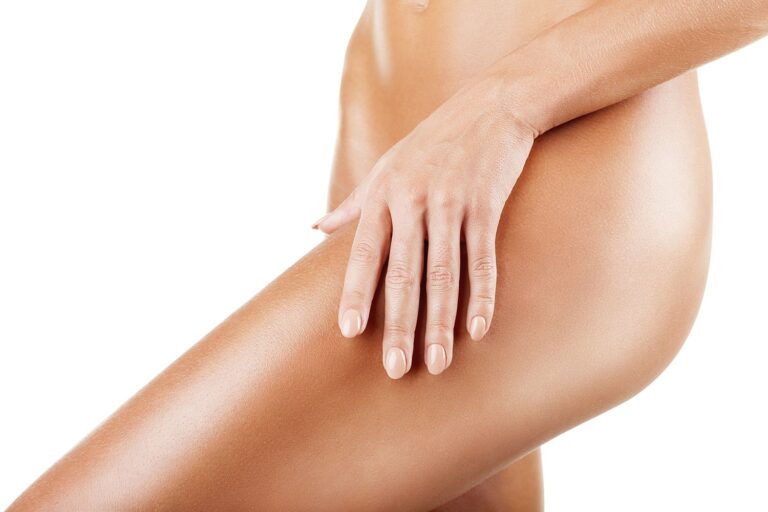Knee liposuction is a cosmetic procedure that can help to reduce fat in the knee area. It is most commonly used for people who have excess fat around the knees, which can cause them to look bulky or disproportionate. The procedure involves removing the fat through small incisions in the skin, using a cannula and suction device. This method is minimally invasive and has very little downtime.
Knee liposuction can be used to remove fat from the inner thighs, outer thighs, and knees. It can also be used to contour and reshape the area to give it a more streamlined appearance. The amount of fat that is removed depends on the individual’s goals and what their doctor recommends.
The procedure takes about an hour and is done under local anesthesia or intravenous sedation. During the procedure, a thin tube called a cannula is inserted into the fat layer beneath the skin through small incisions made around the knee area. The cannula is attached to a suction device that removes the excess fat from the body.
Afterwards, patients may experience some swelling and bruising around the knee area as well as mild discomfort for several days after surgery. Most people are able to return to their normal activities within one week of surgery, although strenuous activities should be avoided for at least two weeks after surgery.
Overall, knee liposuction is an effective way to reduce excess fat in this area and give you slimmer-looking legs with improved contours. It can also help improve your overall body proportions by creating balance between your upper and lower body.
Benefits of Knee Liposuction
Knee liposuction is an effective and relatively safe procedure for those who are looking to reduce excess fat in the knees. It can help improve the overall appearance of the knee and provide a more aesthetically pleasing shape. Additionally, it can also improve mobility and reduce pain in the affected area due to reduced pressure on the joints.
The procedure is minimally invasive, meaning there is no need for large incisions or general anesthesia. Recovery time is usually minimal, with most patients able to return to normal activities within a few days of surgery. The results of knee liposuction are often long-lasting, provided that healthy lifestyle habits are maintained after the procedure.
Benefits for Physical Health
Knee liposuction can help reduce strain on the joints caused by excess fat in the knees, which can lead to improved mobility and less pain when walking or running. This can be especially beneficial for those who participate in sports such as running or cycling, as it can help reduce fatigue and discomfort during physical activity. Additionally, reducing fat around the knees can help reduce inflammation and swelling associated with conditions such as arthritis or bursitis.
Benefits for Mental Health
In addition to physical health benefits, knee liposuction can also have positive effects on mental health. Many people feel self-conscious about their appearance due to excess fat in their knees, which can lead to low self-esteem and body image issues. After undergoing knee liposuction, many patients report feeling more confident in their appearance and more comfortable wearing certain clothing styles that they may have previously been too embarrassed to wear.
Procedure for Knee Liposuction
Knee liposuction is a minimally invasive procedure that removes excess fat from the knees, resulting in a smoother, more contoured appearance. The procedure is typically performed under local anesthesia and can be completed in about an hour.
Step 1: Consultation and Pre-Operative Evaluation
Prior to undergoing knee liposuction, it’s important to consult with a board-certified plastic surgeon who specializes in this type of surgery. During the consultation, the surgeon will evaluate your medical history and discuss your expectations for the outcome of the procedure. It’s important to be honest with your surgeon about any medical conditions or allergies you may have.
Step 2: Administering Anesthesia
Once you are cleared for surgery, the doctor will administer local anesthesia to numb the area being treated. This ensures that you remain comfortable throughout the entire procedure.
Step 3: Making Incisions
The doctor will make small incisions around the knee area so they can access the fatty tissue beneath the skin. Through these incisions, they will insert a thin tube called a cannula which is used to suction out excess fat cells from around the knee area.
Step 4: Suctioning Fat Cells
The doctor will use gentle suctioning motions with the cannula to remove unwanted fat cells from beneath the skin. This process is repeated until all of the excess fat has been removed. The doctor may also use specialized tools such as ultrasound or laser technology to help break up and suction out stubborn pockets of fat cells.
Step 5: Closing Incisions
Once all of the excess fat has been removed, the doctor will close up any incisions using sutures or adhesive strips and apply a bandage over them to protect them from infection.
Knee liposuction is generally considered a safe and effective way to reduce excess fat around the knees and improve their overall appearance. However, it’s important to understand that this procedure is not recommended for those who are significantly overweight or obese as it won’t provide long-lasting results in those cases.
Post-Operative Care After Knee Liposuction
It is important to take proper care of yourself after undergoing knee liposuction surgery. The recovery time can vary depending on the severity of the procedure and the individual’s health. Generally, patients should expect to take at least a week off from work and other activities that require physical exertion.
Pain Management
Patients may experience discomfort in the area around their knees for several days after the surgery. Pain medications may be prescribed by your doctor to help manage any pain or inflammation. It is important to follow your doctor’s instructions carefully when taking these medications.
Compression Garments
Your doctor may also recommend wearing a compression garment over the area where liposuction was performed. This garment helps reduce swelling and provide support while you are healing. It should be worn as directed by your doctor for the duration of your recovery period.
Activity Restrictions
It is important to avoid strenuous activities and exercise during your recovery period. Your doctor will likely advise you to take a few weeks off from any type of physical activity that could potentially cause strain or injury to your knees. Additionally, it is important to avoid swimming or soaking in water during this time as well, as this could lead to infection.

Follow-Up Appointments
Your doctor will likely schedule follow-up appointments with you in order to monitor your progress and make sure that you are healing properly. During these appointments, they may also discuss any additional treatment options or lifestyle changes that could help improve your results from knee liposuction surgery.
By following these post-operative care guidelines, you can ensure that you are able to recover quickly and safely after knee liposuction surgery and enjoy long-lasting results.
Non-surgical treatments, exercise, and dietary changes can help reduce excess fat in the knees.
Other Treatments to Reduce Excess Fat in the Knees
While knee liposuction is a popular and effective treatment for reducing excess fat in the knees, there are other treatments available as well. These treatments can be used alone or in combination with liposuction to achieve the desired results.
Non-Surgical Treatments
Many non-surgical treatments can help reduce excess fat in the knees. CoolSculpting is one of the most popular non-surgical treatments that uses cold temperatures to freeze and eliminate fat cells from targeted areas of the body. Another option is Vaser Lipo, which uses ultrasound technology to break down fat cells before they are removed from the body. Other non-surgical treatments include radiofrequency energy and laser lipolysis.
Exercise
Regular exercise can also help reduce excess fat in the knees. Cardio exercises such as running, cycling, swimming, and walking are all great ways to burn calories and reduce fat deposits in the knees. Strength training exercises such as squats, lunges, and leg presses can also help build muscle mass and tone the legs. It’s important to incorporate regular stretching into your workout routine as well to improve flexibility and reduce risk of injury.
Dietary Changes
Making dietary changes is another way to reduce excess fat in the knees. Eating a healthy diet that is low in saturated fats, added sugars, and processed foods can help you lose weight and improve overall health. Eating more fruits, vegetables, lean proteins, whole grains, nuts, seeds, and healthy fats can also help promote weight loss while providing essential nutrients for optimal health.
Choose whole grains, eat fruits and vegetables, limit added sugars, cut back on sodium, stay hydrated.
Healthy Eating Tips to Reduce Weight and Improve Health
Making healthy food choices is an important part of maintaining a healthy lifestyle. Eating the right foods can help you lose weight, reduce your risk of chronic diseases, and promote overall health. Here are some tips for making healthy dietary choices:
Choose Whole Grains
Whole grains contain more fiber than processed grains, which helps keep you feeling full longer. Try substituting whole-grain breads, pastas, and cereals for their refined counterparts.
Eat Fruits and Vegetables
Fruits and vegetables are packed with essential vitamins, minerals, and antioxidants that can help protect against disease and improve your overall health. Aim to eat at least five servings of fruits and vegetables every day.
Limit Added Sugars
Added sugars provide little nutritional value but can add significant calories to your diet. Limit added sugars by avoiding sugary drinks such as soda, energy drinks, and sweetened teas; candies; cakes; cookies; ice cream; and other desserts.
Cut Back on Sodium
High sodium intake can increase blood pressure levels in some people. To reduce your sodium intake, avoid adding salt to your food while cooking or eating it. You should also limit processed foods such as canned soups, frozen dinners, deli meats, and snack foods like chips or pretzels.
Stay Hydrated
Drinking enough water is important for proper hydration and helps fill you up so you don’t overeat. Aim to drink at least eight glasses of water per day or more if you’re active or live in a hot climate.





